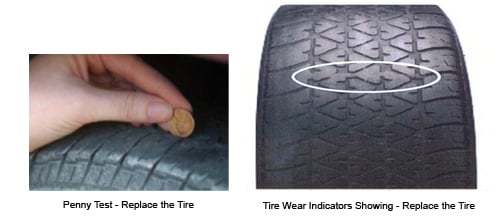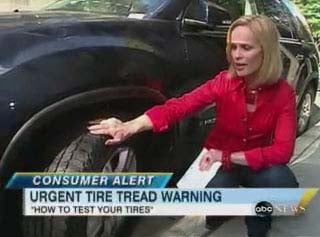How To Check Your Tread
Another critical part of your tire is the tread, which gives you the traction to stop and hold the road on curves. Tire tread also funnels water out from under the tire, which helps to reduce "hydroplaning," where a car actually rides up on a layer of water and becomes dangerously difficult to steer or stop. Well-worn or bald tires can result in hydroplaning or loss of traction and are more likely to be damaged by potholes and other road hazards.
Replace tires when worn to 2/32 inch (1.6 mm) tread depth anywhere on the tread face. To help you see when the tread is worn out, tires have built-in tread-wear indicators at six locations around the tire.
These are narrow bars of smooth rubber that run across the tread. You can also try the penny test: place a penny in the tire's most worn groove with the Lincoln's head facing down. If you can see the top of the Lincoln's head, the tire should be replaced.

According to NHTSA, about one out of every 10 cars on the road has at least one worn-out or bald tire. There are several things you can do to stay out of that group and help the tread last longer on your tires. For starters, make sure that your tire service professional balances your tires when installing them. Balancing involves placing small weights on the rim to counteract heavy spots, or slight variations in weight, in the wheel. If a tire is not balanced, it will shimmy as you drive, and your tread will wear down quickly. You must also make sure that your car’s suspension is properly aligned.
Operating a vehicle with just one tire underinflated by 8 psi (56 kPa) can reduce the life of the tire by 9,000 miles and can increase the vehicle's fuel consumption by 4%. In addition to wear-out, if any of the conditions below are found when inspecting a tire, rim/wheel, or valve, the item should be removed from service. (Note: This list is not all-inclusive.)
- Localized spot wear
- Exposed cord or fabric material
- Unrepairable punctures
- Previous improper repairs
- Bulges, blisters
- Deep cuts/cracks
- Run-flat damage
- Bent, cracked, corroded, or damaged rim/wheel
- Damaged valve and/or valve core
Consult a tire service professional with any questions or concerns regarding tire, rim/wheel, or valve conditions.
